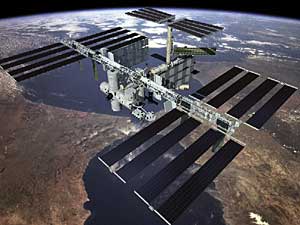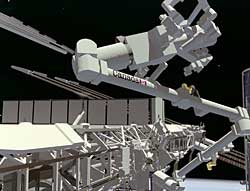 |
 The
International Space Station is the largest and most complex
international scientific project in history. More than four times as
large as the Russian Mir space station, the completed International
Space Station will have a mass of about 1 million pounds. It will
measure about 360 feet across and 290 feet long, with almost an acre
of solar panels to provide electrical power to six state-of-the-art
laboratories.
The
International Space Station is the largest and most complex
international scientific project in history. More than four times as
large as the Russian Mir space station, the completed International
Space Station will have a mass of about 1 million pounds. It will
measure about 360 feet across and 290 feet long, with almost an acre
of solar panels to provide electrical power to six state-of-the-art
laboratories.
The International Space Station will establish an unprecedented
laboratory complex in orbit. Scientists on ISS will study many
things, ranging from crystal growth to  Earth
observation. An important subject of research will be the human body
in zero-g (or, more accurately, microgravity&emdash;even in orbit,
there is a very slight gravitational pull). What happens to muscles,
the heart and arteries, and bones in this microgravity environment?
Such studies will improve our understanding of the human body,
helping us treat common problems on Earth while preparing for
long-term human space exploration like a Mars mission.
Earth
observation. An important subject of research will be the human body
in zero-g (or, more accurately, microgravity&emdash;even in orbit,
there is a very slight gravitational pull). What happens to muscles,
the heart and arteries, and bones in this microgravity environment?
Such studies will improve our understanding of the human body,
helping us treat common problems on Earth while preparing for
long-term human space exploration like a Mars mission.
Learn more about the International Space Station on NASA's Web site.